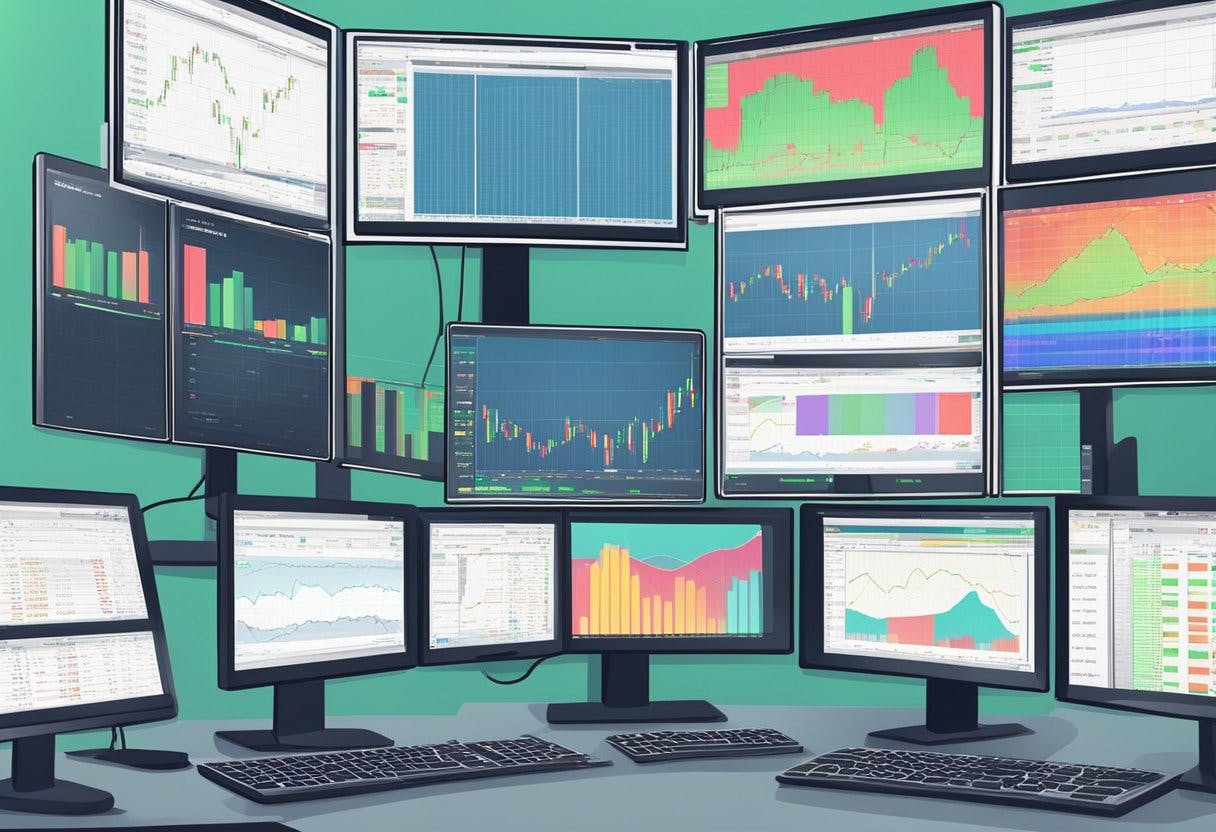
The foreign exchange (Forex) market is one of the most volatile markets in the world. It is characterized by rapid price movements that can occur in a matter of seconds, making it a challenging market for traders to navigate. However, volatility can also present opportunities for traders to profit if they have the right strategy in place.

Understanding Forex market volatility is crucial for any trader looking to succeed in this market. Volatility is the rate at which an asset’s price increases or decreases over a period of time. It is important to note that volatility is not the same as risk. While high volatility can increase the risk of trading, it can also present opportunities for traders to profit if they have the right strategy in place.
Developing a solid trading plan is essential for success in the Forex market. This plan should include effective Forex trading strategies, risk management techniques, and advanced techniques for experienced traders. Continuous learning and adaptation are also key components of a successful Forex trading plan.
Key Takeaways
- Understanding Forex market volatility is crucial for success in Forex trading.
- Developing a solid trading plan that includes effective Forex trading strategies, risk management techniques, and advanced techniques for experienced traders is essential.
- Continuous learning and adaptation are key components of a successful Forex trading plan.
Understanding Forex Market Volatility

Forex trading is a dynamic and constantly evolving market, where prices of currency pairs are constantly fluctuating. One of the most significant factors that influence forex market movements is volatility. In this section, we will explore the definition of volatility in forex, the impact of global events on volatility, and the volatility indicators and tools used by traders.
Defining Volatility in Forex
Volatility in forex refers to the degree of price fluctuations or price swings that a currency pair experiences over a given period. It is a measure of the degree of uncertainty or risk in the market. Volatility is a crucial metric used by traders to assess the level of risk and uncertainty in the forex market. High volatility can provide opportunities for traders to make significant profits, but it also increases the risk of losses.
Impact of Global Events on Volatility
Global events such as economic data releases, political events, and natural disasters can have a significant impact on forex market volatility. For example, news of a natural disaster or political instability can cause a sudden increase in volatility, leading to sharp market movements. Economic data releases such as GDP, inflation, and employment reports can also cause volatility in the forex market. Traders need to stay informed and monitor global events to anticipate potential market movements.
Volatility Indicators and Tools
Traders use various volatility indicators and tools to measure and track market volatility. One of the most popular indicators is the VIX (CBOE Volatility Index), which measures the expected volatility of the S&P 500 index. Other popular volatility indicators used by forex traders include the Average True Range (ATR), Bollinger Bands, and the Relative Strength Index (RSI).
In conclusion, understanding forex market volatility is crucial for traders to make informed trading decisions. Global events, economic data releases, and volatility indicators can all impact market movements and provide opportunities for traders to make profits. It is essential to stay informed, monitor market volatility, and use the right tools and indicators to navigate volatile markets successfully.
Developing a Solid Trading Plan

Developing a solid trading plan is crucial for traders who want to navigate through the ups and downs of a volatile market. A trading plan is a set of guidelines that a trader follows to manage his or her trades. It outlines the trader’s strategy, risk management techniques, and profit targets.
Importance of a Trading Plan
A trading plan is essential for traders who want to succeed in the Forex market. It helps traders to stay disciplined and focused on their goals. A trading plan also helps traders to manage their emotions and avoid making impulsive decisions.
Incorporating Risk Management Strategies
Risk management is an essential part of any trading plan. Traders should always have a risk management strategy in place to protect their capital. One popular risk management technique is to use stop losses. Stop losses are orders that are placed to sell a trade if the price reaches a certain level. This technique helps traders to limit their losses and protect their capital.
Setting Realistic Profit Targets and Stop Losses
Traders should always set realistic profit targets and stop losses. Profit targets are the price levels at which traders plan to exit their trades to take profits. Stop losses are the price levels at which traders plan to exit their trades to limit their losses. Traders should set their profit targets and stop losses based on their risk-reward ratio. The risk-reward ratio is the ratio of the potential profit to the potential loss.
In conclusion, developing a solid trading plan is crucial for traders who want to succeed in a volatile market. A trading plan helps traders to stay disciplined, manage their risks, and set realistic profit targets and stop losses. By following a trading plan, traders can increase their chances of making profitable trades and achieving their goals.
Effective Forex Trading Strategies

When it comes to trading in a volatile forex market, it is essential to have a well-planned strategy in place. Here are some effective forex trading strategies that can help traders navigate through volatile markets.
Technical Analysis for Volatile Markets
Technical analysis is a popular approach that traders use to identify potential market trends and trading opportunities. In a volatile market, technical analysis can be particularly useful as it helps traders to identify patterns and trends that can help them make informed trading decisions. Traders can use technical indicators such as Moving Averages, Bollinger Bands, and Relative Strength Index (RSI) to identify potential entry and exit points.
Utilizing Economic Calendars and News
Economic calendars and news releases can have a significant impact on currency prices. Traders can use economic calendars to stay up-to-date with scheduled news releases and events that can influence the forex market. By staying informed, traders can make informed trading decisions and adjust their trading strategies accordingly.
Diversification Across Currency Pairs
Diversification is an essential aspect of any trading strategy. In a volatile market, diversifying across currency pairs can help traders to spread their risk and avoid overexposure to a single currency. By diversifying their portfolio, traders can increase their chances of making profitable trades and reduce their exposure to market volatility.
In conclusion, trading in a volatile forex market requires a well-planned strategy that includes technical analysis, staying informed with economic calendars and news releases, and diversification across currency pairs. By implementing these strategies, traders can navigate through volatile markets and increase their chances of making profitable trades.
Risk Management in Forex Trading
Forex trading can be a high-risk investment due to the volatile nature of the market. As such, it is crucial to implement effective risk management strategies to protect your capital and minimize losses. Here are some of the key risk management techniques that traders can use to manage their exposure to risk.
Leveraging Stop and Limit Orders
Stop and limit orders are essential tools for managing risk in Forex trading. Stop orders can be used to limit potential losses by automatically closing out a position if the market moves against you. Limit orders, on the other hand, can be used to lock in profits by automatically closing out a position when a certain profit target is reached. By using stop and limit orders, traders can minimize their exposure to risk and protect their capital.
Understanding Position Sizing and Leverage
Position sizing and leverage are also critical components of risk management in Forex trading. Position sizing refers to the number of units of currency that a trader is willing to risk on a given trade. By determining an appropriate position size, traders can limit their exposure to risk and ensure that they are not overextending themselves.
Leverage is another important factor to consider when managing risk in Forex trading. While leverage can amplify potential profits, it can also increase potential losses. As such, it is essential to use leverage judiciously and to ensure that you have sufficient capital to cover any potential losses.
Adapting to Market Sentiment and Movements
Finally, it is crucial to adapt to market sentiment and movements when managing risk in Forex trading. By monitoring market trends and sentiment, traders can adjust their positions and risk management strategies accordingly. For example, if market sentiment is turning bearish, traders may want to reduce their exposure to risk by closing out positions or tightening stop loss orders.
In conclusion, risk management is a critical component of successful Forex trading. By leveraging stop and limit orders, understanding position sizing and leverage, and adapting to market sentiment and movements, traders can protect their capital and minimize losses in a volatile market.
Advanced Techniques for Experienced Traders
Experienced traders in volatile markets often employ advanced techniques to maximize their profits. Here are some techniques that may prove useful:
Scalping and Short-Term Trading Techniques
Scalping is a popular technique among experienced traders that involves making multiple trades in a short period of time to take advantage of small price movements. Traders who use this technique typically hold positions for only a few seconds or minutes before exiting. Short-term trading techniques, on the other hand, involve holding positions for a few hours or days. These techniques require traders to closely monitor market movements and be ready to act quickly.
Interpreting and Responding to Market Changes
Experienced traders understand that the market is constantly changing and that they need to be able to interpret and respond to these changes quickly. They use a variety of tools and techniques to do this, including technical analysis, fundamental analysis, and market sentiment analysis. Technical analysis involves using charts and other tools to identify patterns and trends in market movements. Fundamental analysis involves analyzing economic and financial data to determine the underlying value of an asset. Market sentiment analysis involves monitoring news and social media to gauge how investors are feeling about the market.
Experienced traders also understand the interconnected nature of the market and how different asset classes can affect each other. For example, changes in the stock market can affect currency prices, and changes in commodity prices can affect stock prices. They use this knowledge to make informed trading decisions.
In summary, experienced traders in volatile markets use advanced techniques such as scalping and short-term trading techniques, and they are able to interpret and respond to market changes quickly. They also understand the interconnected nature of the market and use this knowledge to make informed trading decisions.
Continuous Learning and Adaptation
In volatile forex markets, traders must be able to adapt to changing conditions quickly. One of the most important aspects of adapting to a volatile market is continuous learning.
The Role of Continuous Education
Continuous education is a pivotal factor in helping traders recognize common pitfalls and devise strategies to circumvent them. By being aware of potential mistakes, traders can minimize losses and optimize profits. It is important for traders to stay up-to-date with the latest trading strategies, market trends, and economic news.
Forex traders can enroll in online courses, attend seminars, and read books and articles on forex trading to enhance their knowledge. They can also learn from successful traders by following their trading strategies and analyzing their trades.
Staying Informed on Market Trends and Changes
Staying informed on market trends and changes is another crucial aspect of continuous learning. Traders should keep a close eye on political, economic, and social developments that can affect the forex market. This includes monitoring news outlets, reading economic reports, and staying up-to-date on central bank policies.
Traders can also use technical analysis tools to monitor market trends and identify potential trading opportunities. They can use indicators such as Moving Averages, Bollinger Bands, and Relative Strength Index (RSI) to help them make informed trading decisions.
In conclusion, continuous learning and adaptation are key to success in volatile forex markets. Traders who are patient, research-driven, and stay informed on market trends and changes are more likely to succeed in the long run.
Frequently Asked Questions
What indicators are most effective for navigating forex trading in a volatile market?
When it comes to navigating forex trading in a volatile market, traders should consider using indicators such as the Average True Range (ATR), which measures volatility, and the Relative Strength Index (RSI), which helps identify overbought and oversold conditions. Traders can also use Bollinger Bands, which help identify price extremes and potential reversals.
How can traders adapt their stock trading strategies to benefit from forex market volatility?
Traders can adapt their stock trading strategies to benefit from forex market volatility by focusing on currency pairs that are most affected by market volatility. These include the USD/JPY, GBP/USD, and EUR/USD pairs. Traders can also use technical analysis tools such as candlestick charts to identify patterns and trends in the market.
What are some successful day trading approaches for highly volatile forex pairs?
Some successful day trading approaches for highly volatile forex pairs include scalping, which involves making quick trades to profit from small price movements, and breakout trading, which involves entering a trade when the price breaks through a key level of support or resistance.
Can you explain a long volatility strategy in the context of forex trading?
In the context of forex trading, a long volatility strategy involves buying options or other derivatives that increase in value as market volatility increases. This can be a useful strategy during times of market uncertainty, as it allows traders to profit from market movements without necessarily taking a directional position.
What are the key principles for beginners to understand volatility trading in the forex market?
For beginners, it is important to understand that volatility trading in the forex market involves taking on additional risk, and that it is important to have a solid understanding of risk management principles. Traders should also be aware of the impact of news events on market volatility, and should be prepared to adjust their trading strategies accordingly.
What techniques are recommended for profiting from high volatility in the forex market?
Techniques for profiting from high volatility in the forex market include using stop-loss orders to limit potential losses, using trailing stops to lock in profits, and using leverage to increase potential returns. Traders can also consider using options or other derivatives to profit from market movements without necessarily taking a directional position.
Read More




